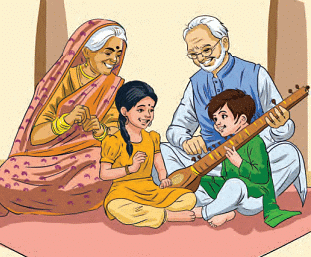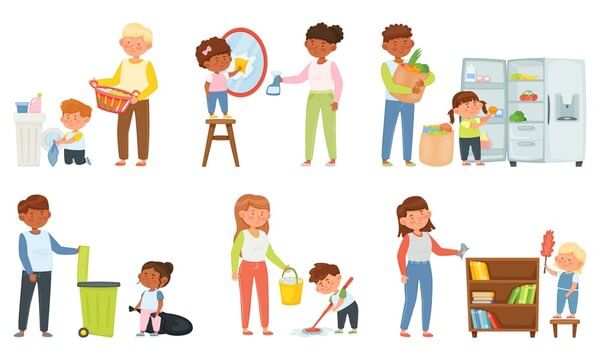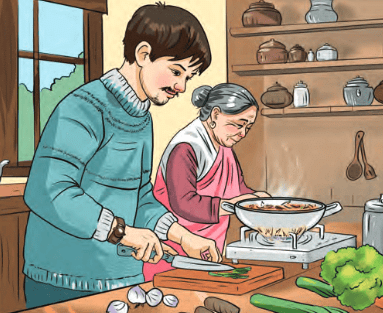The Importance of Families and Communities
Imagine a world where everyone lives alone— it would be lonely and disorganized. Families and communities are important because they provide love, support, and a sense of belonging. Families teach us how to interact with others, while communities help us connect with even more people. Together, they support us, share resources, and preserve traditions, helping to create a balanced and harmonious society.

Family
Family is a crucial part of our lives. It is the oldest and most basic unit of any society.
In Indian society today, there are different types of families:
- Joint families consist of multiple generations living together, including grandparents, parents, uncles, aunts, brothers, sisters, and cousins, all sharing the same household and responsibilities.
A nuclear family has parents and their children living together. Sometimes, it may have just one parent and their children.
 In English, we don’t have many special words for family members, but in Indian languages, there are many! For example, in Hindi, we use words like Bua (aunt), Tau (uncle), Tai (aunt), Chacha (uncle), Mausi (aunt), etc.
In English, we don’t have many special words for family members, but in Indian languages, there are many! For example, in Hindi, we use words like Bua (aunt), Tau (uncle), Tai (aunt), Chacha (uncle), Mausi (aunt), etc.
- Tamil has different words for elder and younger siblings.
- Surprisingly, in many Indian languages, there is no specific word for 'cousin'.
- In many Indian languages, cousins are not referred to as "cousins." Instead, they are simply called brothers and sisters.
- This highlights the strong connections among all the children in a family.
Question for Chapter Notes: Family and Community
Try yourself:Which term is commonly used in Indian languages to refer to cousins?
Explanation
- In Indian languages, cousins are commonly referred to as 'brothers' or 'sisters' to emphasize the close bond and relationship among family members, regardless of their exact relationship.
Report a problem
Roles and Responsibilities
- Family Bonds: Family members love and care for each other. They work together and depend on each other.
- Cooperation: Cooperation means helping and working with each other. Every family member has their own special job to do.
- Parents' Role: Parents help their children grow into happy and responsible people who can contribute to society.
- Children’s Responsibilities: As children grow older, they help their parents and brothers and sisters with household tasks.
- Learning Family Traditions: Kids learn how to be part of family life and follow traditions that have been passed down for many years.
- Dharma: In Indian culture, doing your duty and following what is right is very important.
- Family as a School: The family teaches kids important values like kindness (ahimsa), sharing (dana), helping others (seva), and making sacrifices (tyaga).
- Love and Care: Family members take care of each other and help each other because they love each other.

Story of Shalini's Family in Kerala
- Shalini lives in Kerala with her family. Her father has a small business, and her mother is a teacher. Shalini has a younger brother
- They are preparing for the festival of Onam. Shalini's grandmother, Acchamma, tells Shalini's father that his brother is facing money problems and can't buy new clothes for the festival.

- When Shalini's parents take her and her brother shopping for new clothes, they decide to buy clothes not just for themselves but also for Shalini's uncle, aunt, and cousin.
- Because of this, Shalini doesn't get the fancy silk dress she wanted and has to settle for a simple cotton one.
- Acchamma explains to Shalini that families support each other by sharing what they have.
- Shalini understands and is happy that everyone in the family can get new clothes, even if her dress is simpler.
Tenzing's Life in Meghalaya
- Tenzing lives in a village in Meghalaya, where he loves the mountains, even though life can be challenging.
- His father runs a small grocery store, and his mother is busy with a local handicraft cooperative, making traditional fabrics, wood carvings, and other items for tourists.
- Tenzing's father also helps at home by cleaning, taking care of the vegetable garden, and cooking, often with the help of Tenzing's grandmother.

- Grandmother shares interesting stories with Tenzing, while grandfather helps him with homework and is involved in social work, like helping neighbors during power failures or after storms.
- Tenzing's parents manage to provide for their needs, and they discuss special expenses together, saving money for unexpected future needs.
Families are connected not just to themselves but also to other families and individuals. This network of interconnected people is called a community, although the meaning can vary based on the situation. 
1. Members of a community come together for different reasons, such as:
- Celebrating festivals
- Hosting weddings
- Participating in other events
2. In some rural areas, people work together to help with farming tasks like:
- Preparing the land
- Sowing seeds
- Harvesting crops
3. Over time, communities have made agreements on how to share natural resources such as:
- Water
- Grazing lands
- Forest products
4. This practice is common among many tribal communities and is still seen in some rural villages in India today.
5. These shared practices, which can be called rules, were often not written down but helped communities secure their access to resources.
6. Every family and individual in the community has specific responsibilities they need to fulfill.
7. If these responsibilities are not met, it can lead to problems in how the community operates.
Helping Children Learn: Kamal Parmar's Story
- Kamal’s Workshop: A man named Kamal Parmar had a small workshop in Ahmedabad, Gujarat.
- Helping Poor Children: Kamal saw children on the street who were very poor. Some didn’t go to school, and some had left school.
- Giving Classes: Kamal decided to help them. After his work, he started teaching them from 5:30 pm to 9:30 pm every day.
- Free Dinner: He also gave the children free dinner every day.
- Lots of Children Came: Soon, around 150 children came to his classes regularly and were excited to learn.

Support from Teachers and Older Students
- Teachers Noticed: Some teachers from a nearby school saw Kamal’s classes and wanted to help teach.
- Teacher’s Observation: One teacher saw that even though the children didn’t have proper benches, a quiet place, or were in a noisy environment, they were still very focused and paid attention.
- Teacher’s Connection: The teacher was really moved by the children’s hard work and felt close to them.
- Older Students Help: Some older students who went to regular schools also joined Kamal’s classes to help teach.
- Learning from Children: One of these older students said that instead of just teaching, they learned a lot from the younger children too.
New Types of Communities
- In the past 30 to 40 years, new types of communities have emerged, such as Residents' Welfare Associations in cities.
- These communities create their own guidelines regarding issues like waste management, cleanliness, and pet care.
- Community members collaborate to establish these rules.
- Residents' Welfare Associations also depend on other groups, such as traders for supplies and municipal workers for waste management services.

- This illustrates the interconnectedness of different communities in our complex society.
- The idea of a community is quite flexible. For instance:
1. A jāti (or a subdivision of it) is viewed as a community.
2. A group sharing a common religion, region, profession, or interest can also form a community. Examples include 'Mumbai's Parsi community' or 'Kerala's scientific community'. - In school, you might belong to various communities, such as your class, sports teams, or clubs like the National Service Scheme or the National Cadet Corps.
Examples of Community Support and Environmental Care
1. Jhabua, Madhya Pradesh: The region faced a serious water crisis every year.
2. Bhil Community Action: In line with their halma tradition of supporting each other in times of need, the Bhil community took action to help the environment and their community.- Tree Planting: The Bhils planted thousands of trees across hundreds of villages.
- Water Conservation: They dug trenches and created various water harvesting structures to conserve rainwater.
- Community Service: The Bhils did this work not for payment but as a duty toward their community and the environment, embodying the halma tradition of serving Mother Earth.
3. Acknowledgment: In 2019, Shri Mahesh Sharma of the Shivganga movement was awarded the Padma Shri for his impactful work with the Bhil communities.
4. Chennai Floods 2015: During the floods in Chennai, roads were flooded, making transportation difficult, and most shops and services were closed.
5. Community Response: Many private groups, especially spiritual and religious organizations, came together to cook and distribute large quantities of food to those in need.
Question for Chapter Notes: Family and Community
Try yourself:What is the concept of interdependence in communities?
Explanation
Members of a community are connected not only to one another but also to their families.
People assist each other by sharing resources and collaborating.
Communities unite to celebrate festivals and organise events.
Therefore, all these elements demonstrate the concept of interdependence in communities.
Report a problem
Conclusion
Family and community are very important for everyone. Families teach us how to love, care for others, and be responsible. Communities help by giving support and strength to everyone. Families and communities work together to make life better for all of us. Just like families need love and teamwork, communities need everyone to help and work together. When we understand this, we can make the world a happier and better place.
Key words :
- Family – A group of people related by blood or marriage who care for and support each other.
- Community – A group of people living in the same area or sharing common interests.
- Cooperation – Working together to achieve a common goal.
- Support – Helping or caring for someone.
- Responsibility – The duty to take care of things or people.
- Dharma – Doing the right thing or following your duty in life.
- Tradition – Customs or activities passed down from one generation to another.
- Values – Important ideas or beliefs that guide how we live.
- Volunteer – A person who helps without expecting to be paid.
- Connection – A relationship or bond between people.
- Resource – Things that are helpful or useful, like water or food.
- Environment – The natural world around us, including plants, animals, and land.
- Cooperative – A group of people working together for a common good.
- Sacrifice – Giving up something for the benefit of others.
- Interdependence – Relying on each other to get things done or succeed.



 In English, we don’t have many special words for family members, but in Indian languages, there are many! For example, in Hindi, we use words like Bua (aunt), Tau (uncle), Tai (aunt), Chacha (uncle), Mausi (aunt), etc.
In English, we don’t have many special words for family members, but in Indian languages, there are many! For example, in Hindi, we use words like Bua (aunt), Tau (uncle), Tai (aunt), Chacha (uncle), Mausi (aunt), etc.





















